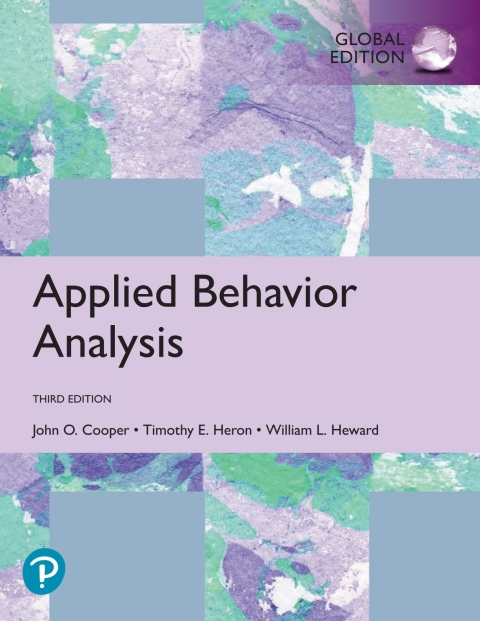Description
Efnisyfirlit
- Title Page
- Copyright Page
- About the Authors
- Chapter Contributors
- Preface
- Acknowledgments
- Brief Contents
- Contents
- PART 1: Introduction and Basic Concepts
- 1 Definition and Characteristics of Applied Behavior Analysis
- Science: Basic Characteristics and a Definition
- A Brief History of Behavior Analysis
- Characteristics of Applied Behavior Analysis
- A Definition of Applied Behavior Analysis
- Summary
- 2 Basic Concepts and Principles
- Behavior
- Environment
- Respondent Behavior
- Operant Behavior
- Recognizing the Complexity of Human Behavior
- Summary
- PART 2: Selecting, Defining, and Measuring Behavior
- 3 Selecting and Defining Target Behaviors
- Role of Assessment in Applied Behavior Analysis
- Assessment Methods Used by Behavior Analysts
- Assessing the Social Significance of Potential Target Behaviors
- Prioritizing Target Behaviors
- Defining Target Behaviors
- Setting Criteria for Behavior Change
- Summary
- 4 Measuring Behavior
- Definition and Functions of Measurement in Applied Behavior Analysis
- Measurable Dimensions of Behavior
- Methods for Measuring Behavior
- Measuring Behavior by Permanent Products
- Measurement Tools
- Selecting a Measurement Method
- Summary
- 5 Improving and Assessing the Quality of Behavioral Measurement
- Indicators of Trustworthy Measurement
- Threats to Valid Measurement
- Threats to Accurate and Reliable Measurement
- Assessing the Accuracy and Reliability of Behavioral Measurement
- Using Interobserver Agreement to Assess Behavioral Measurement
- Summary
- PART 3: Evaluating and Analyzing Behavior Change
- 6 Constructing and Interpreting Graphic Displays of Behavioral Data
- Purpose and Benefits of Graphic Displays of Behavioral Data
- Graphs Used by Applied Behavior Analysts
- Constructing Line Graphs
- Interpreting Graphically Displayed Behavioral Data
- Summary
- 7 Analyzing Behavior Change: Basic Assumptions and Strategies
- Concepts and Assumptions Underlying the Analysis of Behavior
- Components of Applied Behavior Analysis Experiments
- Steady State Strategy and Baseline Logic
- Summary
- 8 Reversal and Multielement Designs
- Reversal Design
- Multielement Design
- Summary
- 9 Multiple Baseline and Changing Criterion Designs
- Multiple Baseline Design
- Changing Criterion Design
- Summary
- 10 Planning and Evaluating Applied Behavior Analysis Research
- Importance of the Individual Subject in Behavior Analysis Research
- Importance of Flexibility in Experimental Design
- Internal Validity: Controlling Potential Sources of Confounding in Experimental Design
- Social Validity: Assessing the Applied Value of Behavior Changes and the Treatments That Accomplish
- External Validity: Replicating Experiments to Determine the Generality of Research Findings
- Evaluating Applied Behavior Analysis Research
- Summary
- PART 4: Reinforcement
- 11 Positive Reinforcement
- Positive Reinforcement Defined
- Classifying Reinforcers
- Identifying Potential Reinforcers
- Control Procedures for Positive Reinforcement
- Using Reinforcement Effectively
- Summary
- 12 Negative Reinforcement
- Definition of Negative Reinforcement
- Escape and Avoidance Contingencies
- Characteristics of Negative Reinforcement
- Applications of Negative Reinforcement
- Changes in Teacher and Caregiver Responding as a Function of Negative Reinforcement
- Ethical Considerations in Using Negative Reinforcement
- Summary
- 13 Schedules of Reinforcement
- Intermittent Reinforcement
- Defining Basic Intermittent Schedules of Reinforcement
- Schedule Effects and Consistency of Performance
- Thinning Intermittent Reinforcement
- Variations on Basic Intermittent Schedules of Reinforcement
- Compound Schedules of Reinforcement
- Perspectives on Using Schedules of Reinforcement in Applied Settings
- Summary
- PART 5: Punishment
- 14 Positive Punishment
- Definition and Characteristics of Punishment
- Factors That Influence the Effectiveness of Punishment
- Possible Side Effects and Problems with Punishment
- Positive Punishment Interventions
- Guidelines for Using Punishment
- Ethical Considerations Regarding the use of Punishment
- Concluding Perspectives
- Summary
- 15 Negative Punishment
- Time-Out from Positive Reinforcement Defined
- Time-Out Tactics for Applied Settings
- Using Time-Out Effectively
- Response Cost Defined
- Response Cost Methods
- Using Response Cost Effectively
- Response Cost Considerations
- Summary
- PART 6: Antecedent Variables
- 16 Motivating Operations
- Definition and Characteristics of Motivating Operations
- Distinguishing Between MOs and SDs
- Unconditioned Motivating Operations (UMOs)
- MOs for Punishment
- Multiple Effects of MOs
- Conditioned Motivating Operations (CMOs)
- Relevance of MOs to the Generality of Treatment Effects
- Relevance of MOs to Applied Behavior Analysis
- Summary
- 17 Stimulus Control
- Stimulus Control: Basic Concepts and Processes
- Developing Stimulus Control
- Transferring Stimulus Control
- Summary
- PART 7: Verbal Behavior
- 18 Verbal Behavior
- Skinner’s (1957) Analysis of Verbal Behavior
- The Verbal Operants and Listener Behavior in More Detail
- Listener Behavior
- Autoclitic Verbal Behavior
- Applications of Skinner’s (1957) Analysis of Verbal Behavior
- Applications to Language Assessment and Intervention
- The Loss of Verbal Behavior
- Summary
- PART 8: Developing New Behavior
- 19 Equivalence-based Instruction
- Research Foundations and Core Concepts
- Designing Equivalence-Based Instruction
- Applications and Generality
- Applications Stemming from Alternative Theoretical Approaches to Relational Responding
- Concluding Remarks
- Summary
- 20 Engineering Emergent Learning with Nonequivalence Relations
- What are Nonequivalence Relations? Why do They Matter?
- The Vocabulary of Nonequivalence Relations
- Some Types of Nonequivalence Relations
- Theoretical Foundations
- Nonequivalence Relations and Big-Picture Psychological Constructs
- Derived Stimulus Relations and General Well-Being
- A Final Comment
- Summary
- 21 Imitation, Modeling, and Observational Learning
- Imitation
- Modeling
- Observational Learning
- Summary
- 22 Shaping
- Shaping Defined
- Shaping Across and Within Response Topographies
- Increasing Shaping Efficiency
- Clicker Training
- Emerging Applications of Shaping
- Shaping Guidelines
- Learning to Shape
- Summary
- 23 Chaining
- Behavior Chain Defined
- Rationale for Chaining
- Establishing Behavior Chains with Task Analysis
- Behavior Chaining Methods
- Choosing a Chaining Method
- Disrupting and Breaking Behavior Chains
- Troubleshooting Chains
- Factors Affecting the Performance of Behavior Chains
- Summary
- PART 9: Decreasing Behavior with Nonpunishment Procedures
- 24 Extinction
- Extinction Defined
- Extinction Procedures
- Secondary Effects of Extinction
- Variables Affecting Resistance to Extinction
- Using Extinction Effectively
- When Not to Use Extinction
- Summary
- 25 Differential Reinforcement
- Differential Reinforcement Defined
- Differential Reinforcement of Alternative Behavior (DRA)
- Differential Reinforcement of Other Behavior (DRO)
- Differential Reinforcement of Low Rates of Responding (DRL)
- Summary
- 26 Antecedent Interventions
- Defining and Classifying Antecedent Interventions
- Noncontingent Reinforcement
- High-Probability Instructional Sequence
- Functional Communication Training
- Default Interventions
- Summary
- PART 10: Functional Assessment
- 27 Functional Behavior Assessment
- Functions of Behavior
- Role of Functional Behavior Assessment in Intervention and Prevention
- Overview of FBA Methods
- Conducting a Functional Behavior Assessment
- Case Examples Illustrating the FBA Process
- Summary
- PART 11: Special Applications
- 28 Token Economy, Group Contingencies, and Contingency Contracting
- Token Economy
- Group Contingencies
- Contingency Contracting
- Summary
- 29 Self-Management
- The “Self” as Behavior Controller
- Self-Management Defined
- Applications, Advantages, and Benefits of Self-Management
- Antecedent-Based Self-Management Tactics
- Self-Monitoring
- Self-Administered Consequences
- Other Self-Management Tactics
- Suggestions for Effective Self-Management Programs
- Behavior Changes Behavior
- Summary
- PART 12: Promoting Generalized Behavior Change
- 30 Generalization and Maintenance of Behavior Change
- Generalized Behavior Change: Definitions and Key Concepts
- Planning for Generalized Behavior Change
- Strategies and Tactics for Promoting Generalized Behavior Change
- Modifying and Terminating Successful Interventions
- Guiding Principles for Promoting Generalized Outcomes
- Summary
- PART 13: Ethics
- 31 Ethical and Professional Responsibilities of Applied Behavior Analysts
- What Is Ethics and Why Is It Important?
- Standards of Professional Practice for Applied Behavior Analysts
- Ensuring Professional Competence
- Ethical Issues in Client Services
- Coordinating with Other Professionals
- Social Media and New Technologies
- Advocating for the Client
- Conflict of Interest
- Creating a Culture of Ethical Practice
- Conclusion
- Summary
- Epilogue
- Glossary
- A
- B
- C
- D
- E
- F
- G
- H
- I
- J
- L
- M
- N
- O
- P
- R
- S
- T
- U
- V
- W
- Bibliography
- Name Index
- Subject Index







Reviews
There are no reviews yet.